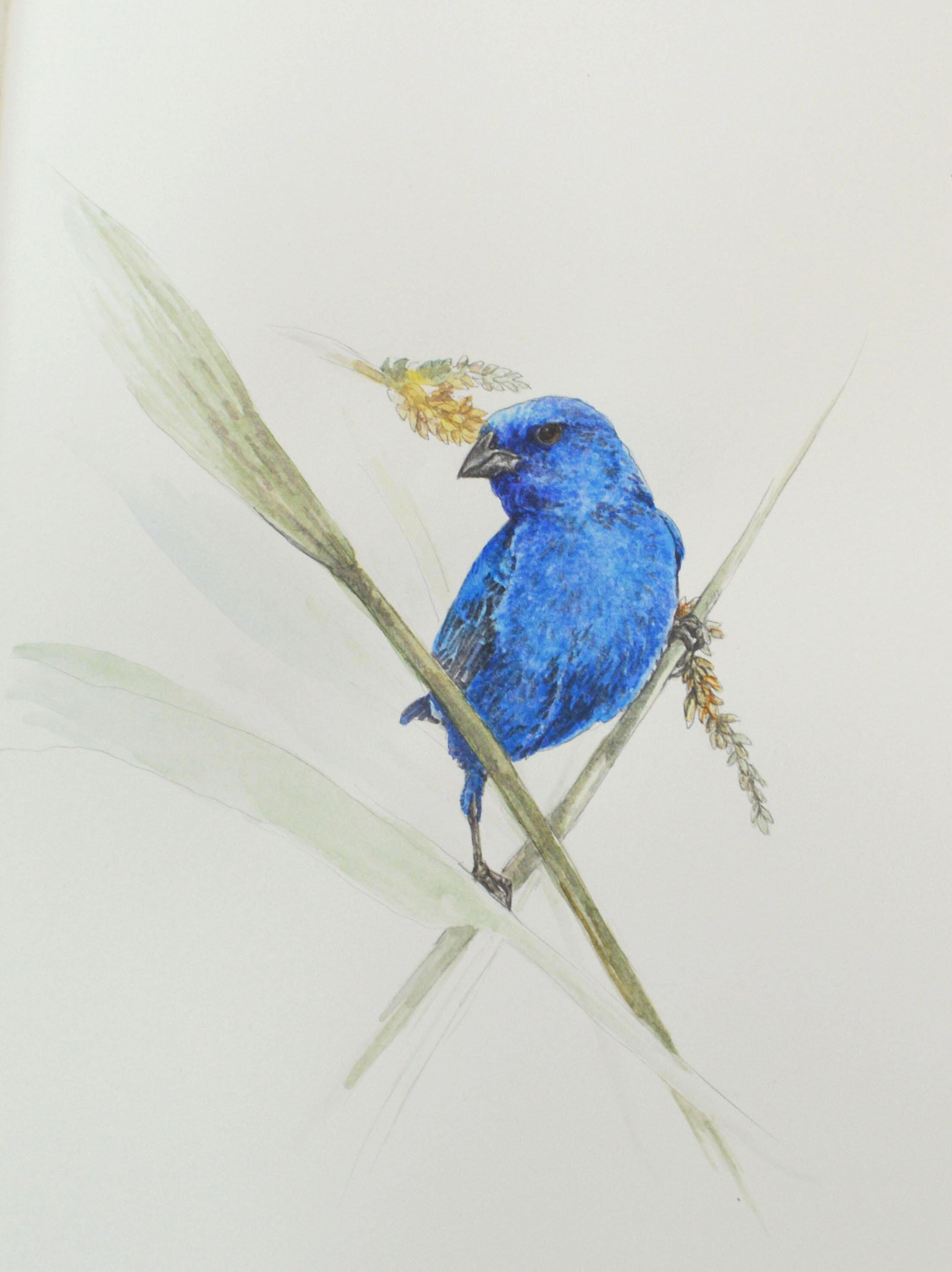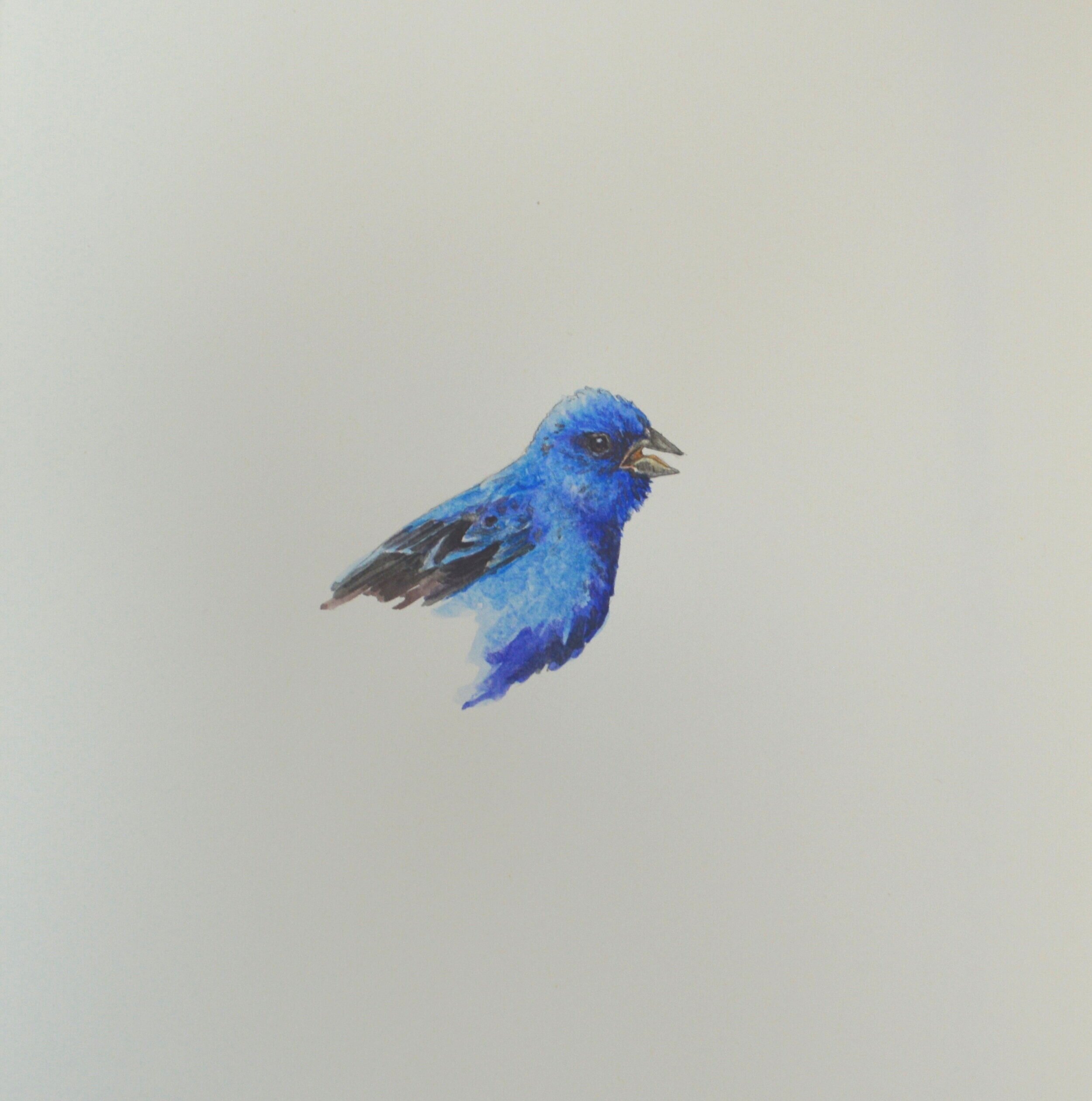Of Birds and Meadows: Q&A with artist Kandis Phillips
OSGF
The Oak Spring Garden Foundation was excited to welcome Kandis Phillips, a natural science illustrator based in Gaithersburg, Maryland, for an onsite residency this summer.
Kandis is a recipient of our inaugural 2020 Botanical Artists in Residence program. After being selected for the BAiR, she was also selected for our Shelter in Art exhibition, for which she submitted several beautiful illustrations of bird nests (see her “Dwellings of Possibilities” collection here.)
Kandis is interested in exploring the relationships between birds and plants, and spent much her time at Oak Spring observing the interactions between our grassland birds and the flora in their habitat, as well as learning about OSGF’s bird conservation efforts. She typically works in metalpoint,* a Renaissance era drawing technique that uses actual metal and coated paper, but was inspired to create her first watercolor studies of birds in over a decade during her stay at Oak Spring.
Scroll down to read more about Kandis’ work and her experience at OSGF.
What is your everyday art practice like?
A Red Wing Blackbird nest drawing using silverpoint. Kandis gifted the finished piece to the Oak Spring Garden Library.
If I'm at the (Museum of Natural History), which is now closed, I basically do my work at home. So I just go down and select the plants from the herbarium and make photocopies of them, and that's what I bring home and work from.
I take my inspiration from the plants that Emily Dickinson collected and pressed and wrote about in her letters and her poetry, and how she used those plants symbolically, and birdlife I see, and their nests. Initially when I started doing nest drawings, I think it was 5 years ago, it was because I walked through the curious section at the museum – they have displays for hands-on interaction with some museum specimens ranging from minerals to dinosaur bones - and they had these nests on display. There was a Marsh Wren nest, and that was the most intricate thing I'd ever seen. I took some photographs of these nests and started drawing them, but they're artifacts on display for educational purposes. They're frequently misshapen, or they're bent together with string so that they don't completely fall apart, because that's what they're meant to do.
Earlier last fall, I was driving around and I saw what looked like a small wasp’s nest. It intrigued me that this was so small, and I was astonished that it was actually a bird’s nest. I figured that it was a Vireo nest, so I took photographs of that and started drawing it, and that was the first nest I'd drawn that was not a museum specimen.
This was the year for the tree trimmers to come by in early March to prune the trees under the power lines along the street behind our house. They removed a fairly large nest that was primarily built from straw - maybe a wrens nest - from underneath a transformer because it was a fire hazard. I started wondering, where did this bird find all this straw in order to build its nest? It was from a quarter of a mile way, where somebody had re-seeded their yard, so they had all this straw. So this bird had made hundreds of trips to collect this material to make this nest, which the tree trimmers had determined to be a hazard and tossed it aside. It struck me how the birds had been building this structure right over the sidewalk I walked on daily but and I never noticed it.
You have been exploring bird-plant relationships here at Oak Spring. What have you observed?
An in-progress milkweed drawing done in ink.
Because this is a meadow, not a forest, the birds utilize the tall growing plants as they look out to see potential danger or to see competitors coming into their territory. The Red Wing Blackbirds I've noticed are very territorial - they don't put up with anything! So that's been interesting. And to see how these plants are going to seed, how these birds initially used them as look-outs and now they're using them as food sources. With the dogbane and milkweed, there's beetles and caterpillars on there, and other tiny insects. They're little insect magnets, so the bird doesn’t need to go ranging too far for a ready food source. The grasses themselves harvest so many crickets and grasshoppers and firefly larvae, and that's really interesting.
I thought a meadow was a sterile community, but I was totally wrong! To see how these birds and the plants that grow there interact, and how they use these grasses and dry materials for their nests, it's this wonderful working system.







Out of all the birds you’ve seen at Oak Spring, do you have a favorite?
The bobolinks. They're got this beautiful, bubbly melody - Emily Dickinson described it as this bubbly, flowing song.
And hearing the meadowlarks down by the runway - I would stand out there, and they are calling, it’s like they are catching up on the morning news. They're making this call, and one answer way over here, and one answer way over there. You don't see them, but you get this kind of echo effect, like they're ventriloquists.
“The Bobolink is gone —
The Rowdy of the Meadow —
And no one swaggers now but me —
The Presbyterian Birds
Can now resume the Meeting
He boldly interrupted that overflowing Day
When supplicating mercy
In a portentous way
He swung upon the Decalogue
And shouted let us pray —
”
Is there anything else you’ve seen here that struck you as particularly interesting?
As I have said before, the bird- plant interactions has been wonderful to observe. In the Library it was seeing the Mattioli Commentarii, printed on blue paper which was highly unusual for the time, about 1565 I believe.
A metalpoint drawing on paper covered in woad, a dye plant that is also grown at the Biocultural Conservation Farm. Kandis gifted the drawing and the woad to the Oak Spring Garden Library.
I'm really interested in the use of blue pigments and papers, like Da Vinci and Durer did with their chalk drawings as well as their metalpoint drawings. They used blue papers, and blue is considered precious and valuable, it was a symbol of divinity.
I used to do a lot of medieval-type illuminations, and so I have these materials and was thinking, how could I incorporate this into a metalpoint drawing without it looking kitschy or something? I looked at the Mattioli and thought Bingo, that's it.
One page that we looked at of a lavender plant was extraordinary in its detail especially when you remember that these images were carved on wood blocks. The woodblock was carved in such a way that its tiny leaves were either heavily shaded to recede and the front leaves had little to no shading so they appeared to really move forward especially after they were illuminated with silver and gold. It’s an exquisite piece of art.
Is there anything else you'd like to say about your residency at Oak Spring?
This has been an extraordinary experience. Everybody here loves what they're doing, they've been so helpful and friendly, and just being in this beautiful place after the pandemic, and this disaster. I’ve been in isolation since the first part of March, and so I’ve only seen my husband; a type of loneliness sets in because there’s no personal contact with other family members, friends, no normal routine. There's a quote by Marianne Moore, “ the cure for loneliness is solitude.”
At first I was concerned about being totally isolated down here in the Bank House for the first two weeks, but it was a very rich time, and very rewarding. Being able to go out and walk with no time constraints on me whatsoever to explore this new environment and to really think about these Meadow birds and their interactions with plants was truly a gift.
*Metalpoint is a technique that allows the artist to draw very fine lines. While silver is the most common metal used by metalpoint artists, a variety of metals - even aluminum soda can tabs and copper piping - can create reflective layers that change color as the artwork ages, as Kandis demonstrated to Oak Spring staff. Learn more about metalpoint here.)
All images, including the cover image of bobolinks, are by Kandis Phillips.
Interested in coming to Oak Spring for a residency? We are still accepting applications for a number of opportunities for artists, scholars, scientists, writers, and more in 2021, including a 1-3 week residency for botanical artists. Visit osgf.org/residencies and osgf.org/felllowships for more information.




